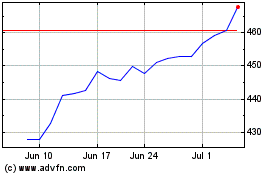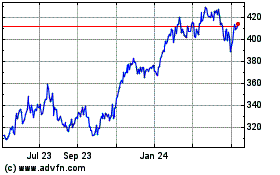Microsoft Gets Lift From Cloud Gains -- WSJ
July 20 2016 - 3:04AM
Dow Jones News
By Jay Greene
Microsoft Corp. remains a distant second to Amazon.com Inc. in
cloud computing, but the software giant's latest quarterly results
suggest that it is effectively managing the transition from selling
software licenses to selling on-demand computing services.
In its fiscal fourth quarter, sales of the Redmond, Wash.,
company's Azure cloud computing service more than doubled,
offsetting a decline in the segment that includes its flagship
Windows operating system and its struggling mobile-phone
business.
The strength of Microsoft's cloud business surprised investors.
The company beat expectations for both sales and profit, which
spurred a 4% rise in Microsoft's shares in after-hours trading.
Microsoft has proved especially adept at selling its cloud
services to existing customers, taking advantage of longstanding
relationships with companies that have run its software in their
own data centers.
"They are effectively getting their customers to transition to
the cloud, " Stifel Nicolaus & Co. analyst Brad Reback
said.
Microsoft's transition to the cloud comes with an important
cost: eroded margins. When the company relied on software licenses
sold to companies every few years, it registered fat profits. But
margins on cloud services, which are sold by subscription, are
slimmer.
For the quarter, gross margins slid 14% to $12.64 billion.
Microsoft Chief Financial Officer Amy Hood expected margins to
decline slightly in the next year as well, she said in an
interview.
Chief Executive Satya Nadella in his two years on the job has
orchestrated the shift. In the process, he has pulled Microsoft
back from its mobile-phone investments championed by his
predecessor Steve Ballmer.
In May, Microsoft further dismantled the acquisition of Nokia
Corp.'s handset business, contributing to a $1.1 billion charge in
the quarter. Ms. Hood said the charge "reflects all of our
judgments today" about the business.
Microsoft's decision to roll back the phone business -- along
with a continuing decline in sales of personal computers that run
its Windows operating system -- led the company to post its first
decline in annual revenue since 2009. Sales fell 8.8% to $85.32
billion in fiscal 2016.
For the year, revenue from the reporting segment that includes
Windows and mobile phones fell 6.3% to $40.46 billion. For the
fourth quarter, sales in that segment fell to $8.9 billion, a
decline of 3.7% year over year (2% in constant currency), even as
revenue from sales of Windows to computer makers rose 11%.
The decline in annual revenue didn't trouble investors.
"It's really important to focus on what's growing and what's
falling," Mr. Reback said. "Everything that matters grew and grew
at a good clip."
The biggest gains came in the segment that includes the Azure
cloud computing services. There, revenue amounted to $6.71 billion,
a rise of 6.6%, or 9.6% in constant currency. Notably, revenue for
Azure alone grew 102% (108% in constant currency) year over
year.
The other big gain came in the segment that includes Microsoft's
Office productivity tools as well as its Dynamics business
programs. That segment posted sales of $6.97 billion, a
year-over-year gain of 4.6%, or 7.6% in constant currency. Revenue
from commercial sales of the cloud-based Office 365 jumped 54%.
Ms. Hood said that with some investments in cloud infrastructure
in the rear-view mirror, she expected Microsoft to begin reaping
economies of scale.
"We have invested heavily to build [market] share, expand
geographically and ensure world-class support and reliability for
our commercial customers," she said. "Going forward, we expect
those investments to provide benefits of scale. We also anticipate
our cloud capital expenditure growth curve will slow."
Microsoft posted $3.12 billion in fourth-quarter net income, or
39 cents a share, compared with a loss of $3.2 billion, or 40 cents
a share, a year ago. The year-earlier results included $8.4 billion
in charges related to the company's mobile-phone operation.
Excluding the impact of revenue deferrals and restructuring
charges, adjusted earnings rose to 69 cents from 62 cents a year
earlier. Revenue slid 7.1% to $20.61 billion and was $22.64 billion
on an adjusted basis.
Analysts surveyed by Thomson Reuters had expected Microsoft to
report adjusted earnings per share of 58 cents and sales of $22.1
billion.
Write to Jay Greene at Jay.Greene@wsj.com
(END) Dow Jones Newswires
July 20, 2016 02:49 ET (06:49 GMT)
Copyright (c) 2016 Dow Jones & Company, Inc.
Microsoft (NASDAQ:MSFT)
Historical Stock Chart
From Mar 2024 to Apr 2024

Microsoft (NASDAQ:MSFT)
Historical Stock Chart
From Apr 2023 to Apr 2024
